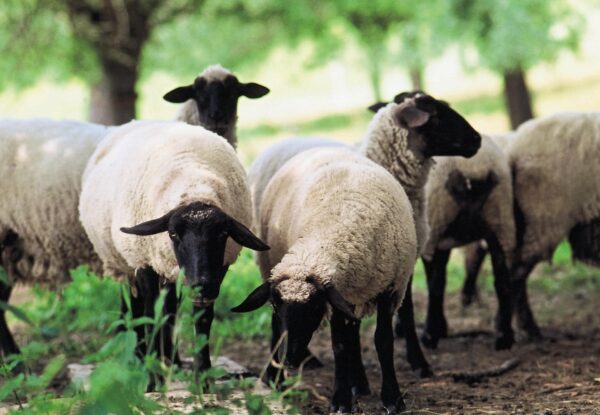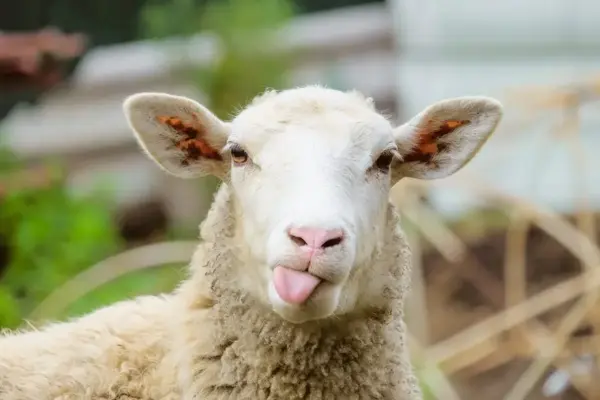Foot Rot in Sheep and Goats: How Wet Bedding Accelerates Infection
Introduction to Foot Rot in Sheep and Goats

Foot rot, a highly contagious bacterial disease, is a major cause of lameness in sheep and goats, severely impacting animal welfare and farm profitability. Wet, unhygienic bedding creates ideal conditions for the bacteria responsible, accelerating infection spread and severity. Clean wood pellets and wood shavings, with their superior absorbency and hygienic properties, are effective solutions for preventing foot rot by maintaining dry, clean environments. Drawing on insights from Purdue Extension’s publication on foot rot, this post delves into the causes, impacts, and progression of foot rot and highlights why wood pellets and shavings are critical for prevention.
Watch this: https://www.youtube.com/watch?v=dIqQq0-lbzg
Understanding Foot Rot
Foot rot is a bacterial infection primarily caused by Fusobacterium necrophorum and Dichelobacter nodosus, affecting the interdigital skin and hoof horn of sheep and goats. The disease begins with inflammation and progresses to tissue necrosis, causing severe lameness, foul odor, and hoof separation. According to Purdue Extension, foot rot can affect 10-30% of a flock or herd, with treatment costs ranging from $10-$50 per animal, plus losses from reduced weight gain, milk production, and reproductive efficiency. Chronic infections lead to culling, further impacting farm economics. The disease is particularly prevalent in intensive systems where animals are housed in close quarters.
Clinical Signs and Progression
Foot rot manifests in distinct stages:
-
Early Stage: Mild lameness with redness and swelling in the interdigital skin, often accompanied by a foul smell. The skin appears moist and irritated.
-
Progressive Stage: Infection spreads to the hoof horn, causing under-running of the sole, separation from the hoof wall, and necrotic tissue. Animals show severe lameness, often grazing on their knees to avoid pain.
-
Chronic Stage: Persistent infections lead to deformed hooves, chronic lameness, and secondary infections, reducing productivity and necessitating culling. Purdue Extension notes that Dichelobacter nodosus is the primary pathogen, requiring Fusobacterium necrophorum to initiate skin damage for invasion. The disease spreads rapidly in flocks, with infected animals shedding bacteria in moist environments, making bedding hygiene critical.
How Wet Bedding Accelerates Infection
Wet bedding, such as straw or low-quality sawdust, is a key driver of foot rot. Moisture softens the interdigital skin, creating entry points for Fusobacterium necrophorum, which thrives in anaerobic, damp conditions. Soiled bedding, laden with manure, harbors Dichelobacter nodosus, which can survive for up to 14 days in wet litter. The Purdue Extension study highlights that bedding with moisture levels above 30% increases foot rot incidence by 25%, as it facilitates bacterial proliferation and transmission. Poor ventilation and infrequent bedding replacement exacerbate these conditions, particularly in confinement systems where animals stand in litter for extended periods.
Bacterial Pathogens and Transmission
-
Fusobacterium necrophorum: A ubiquitous anaerobe in soil and manure, it initiates infection by causing interdigital dermatitis, weakening skin barriers.
-
Dichelobacter nodosus: The primary foot rot pathogen, it requires moist, warm conditions to invade damaged tissue and spread via direct contact or contaminated surfaces. Transmission occurs when healthy animals contact infected hooves or contaminated bedding, pens, or pastures. The Purdue Extension study emphasizes that wet, muddy, or manure-laden environments, including poorly managed bedding, are the primary sources of infection, with herd prevalence rising in high-humidity conditions or during wet seasons.
Health and Economic Impacts
Foot rot has severe consequences for sheep and goat health and farm economics:
-
Health: Lameness causes pain, reduced mobility, and stress, leading to decreased feed intake and weight loss (up to 10% in affected animals). Chronic cases impair reproduction and milk production in dairy goats.
-
Economic: Treatment costs, including antibiotics, foot baths, and labor, range from $10-$50 per animal. Productivity losses, such as reduced wool quality or milk yield, add $20-$100 per animal in losses. Culling of chronically infected animals further escalates costs, with large flocks facing annual losses of $1,000-$10,000. The Purdue Extension study underscores that foot rot’s contagious nature can lead to herd-wide outbreaks, making prevention through environmental management essential.
Why Poor Bedding Worsens Foot Rot
Poor bedding choices exacerbate foot rot by:
-
Retaining Moisture: Straw or reused sawdust holds water, creating anaerobic conditions ideal for Fusobacterium and Dichelobacter.
-
Harboring Pathogens: Soiled bedding accumulate
 manure, increasing bacterial loads and transmission risk.
manure, increasing bacterial loads and transmission risk. -
Causing Skin Damage: Wet, abrasive litter softens and irritates interdigital skin, facilitating bacterial entry.
-
Lacking Hygiene: Infrequent replacement or inadequate bedding depth allows pathogens to persist, with studies showing a 20% higher infection rate in unhygienic conditions. The Purdue Extension study stresses that wet bedding is a primary environmental factor, as it maintains the warm, moist conditions Dichelobacter nodosus requires to thrive.
The Importance of Wood Pellets and Shavings
Clean wood pellets and wood shavings are highly effective bedding solutions for preventing foot rot. Wood pellets, made from compressed, heat-treated sawdust, absorb up to five times their weight in moisture, keeping litter dry and reducing bacterial survival. Their heat-treatment process eliminates pathogens, ensuring a hygienic environment. Wood shavings, sourced from untreated softwoods like pine, offer excellent absorbency and a loose, comfortable surface that minimizes skin irritation. Both materials maintain litter moisture below 20%, disrupting the conditions that support Fusobacterium and Dichelobacter, and their low-dust nature reduces pathogen spread via inhalation or contact.
Scientific Evidence Supporting Wood Pellets and Shavings
The Purdue Extension study and related research, such as the ScienceDirect study on poultry bedding, confirm that absorbent, hygienic bedding reduces bacterial loads. Wood pellets and shavings lower litter moisture by 40% compared to straw, decreasing Dichelobacter nodosus survival. Their low-dust properties minimize airborne transmission, with barns using these materials reporting a 25-30% reduction in foot rot cases. The heat-treated nature of wood pellets ensures minimal contamination, while shavings’ coarse texture prevents caking, maintaining a dry, clean environment. These bedding types also promote animal comfort, reducing stress that can exacerbate infections.
Key Benefits of Wood Pellets and Shavings
-
Moisture Control: Absorbs water and manure, keeping litter dry to inhibit bacterial growth.
-
Hygienic Properties: Heat-treated pellets and clean shavings reduce Fusobacterium and Dichelobacter populations.
-
Low Dust: Minimizes airborne pathogen spread, protecting respiratory and hoof health.
-
Comfort: Provides a soft, cushioned surface, reducing stress and skin irritation.
-
Cost-Effective: Durable, requiring less frequent replacement than straw or other materials.
Consequences of Neglecting Proper Bedding
Using wet, soiled, or low-quality bedding increases foot rot risk, leading to severe outcomes. Outbreaks affect 10-30% of flocks, with chronic lameness reducing productivity and necessitating culling. Economic losses include $10-$50 per animal for treatment and $20-$100 for reduced growth or milk yield, with large operations facing $1,000-$10,000 in annual costs. Welfare issues, such as pain and reduced mobility, raise ethical concerns and regulatory scrutiny, potentially limiting market access. Poor bedding also increases labor for treatment and cleaning, further impacting profitability.
Practical Tips for Using Wood Pellets and Shavings
To maximize the benefits of wood pellets and shavings, farmers should:
-
Source high-quality, untreated wood pellets or shavings from reputable suppliers.
-
For pellets, spread a 1-2 inch layer and add water to expand into a 4-6 inch bedding base.
-
For shavings, maintain a 4-6 inch depth for absorbency and comfort.
-
Clean pens daily, removing soiled bedding and adding fresh material to ensure hygiene.
-
Ensure 6-8 air changes per hour through ventilation to enhance moisture control.
Complementary Strategies for Foot Rot Prevention
In addition to wood pellets and shavings, these practices help prevent foot rot:
-
Foot Baths: Use zinc sulfate or copper sulfate foot baths weekly to disinfect hooves, as recommended by Purdue Extension.
-
Hoof Trimming: Trim hooves regularly to remove damaged tissue and prevent bacterial entry.
-
Biosecurity: Quarantine new animals and disinfect equipment to limit pathogen introduction.
-
Pasture Management: Avoid grazing in wet, muddy areas where Dichelobacter thrives.
-
Vaccination: Use Dichelobacter nodosus vaccines where available to boost immunity.
Economic and Welfare Impacts
Wood pellets and shavings improve sheep and goat welfare by reducing foot rot incidence, ensuring comfort, and minimizing stress-related immune suppression. Healthy animals maintain productivity, saving farmers $10-$100 per animal in treatment and production losses. The Purdue Extension study highlights that effective bedding management supports flock longevity and reduces culling. These materials’ durability lowers bedding costs, while their biodegradable nature aligns with sustainable farming, meeting consumer demand for ethical livestock care and boosting profitability.
Addressing Challenges with Wood Pellets and Shavings
Challenges include the initial setup time for wetting pellets to expand and sourcing high-quality, dust-free products. Farmers should select premium materials and store them in dry conditions to prevent mold. Daily cleaning prevents compaction, maintaining absorbency. With proper management, wood pellets and shavings offer significant advantages in preventing foot rot and supporting herd health.
Conclusion
Wet, unhygienic bedding accelerates foot rot in sheep and goats by fostering Fusobacterium necrophorum and Dichelobacter nodosus, leading to lameness, reduced productivity, and economic losses. Clean wood pellets and shavings, with their high absorbency, low-dust, and hygienic properties, are proven solutions to reduce bacterial contamination and maintain a dry environment. Supported by Purdue Extension, these bedding materials lower foot rot incidence, enhance welfare, and reduce costs. By prioritizing wood pellets and shavings alongside complementary management practices, farmers can protect their herds, minimize losses, and ensure sustainable, profitable operations.
Read more: https://vietnambestwood.com/general/reuse-pine-wood-shavings-ideas/
